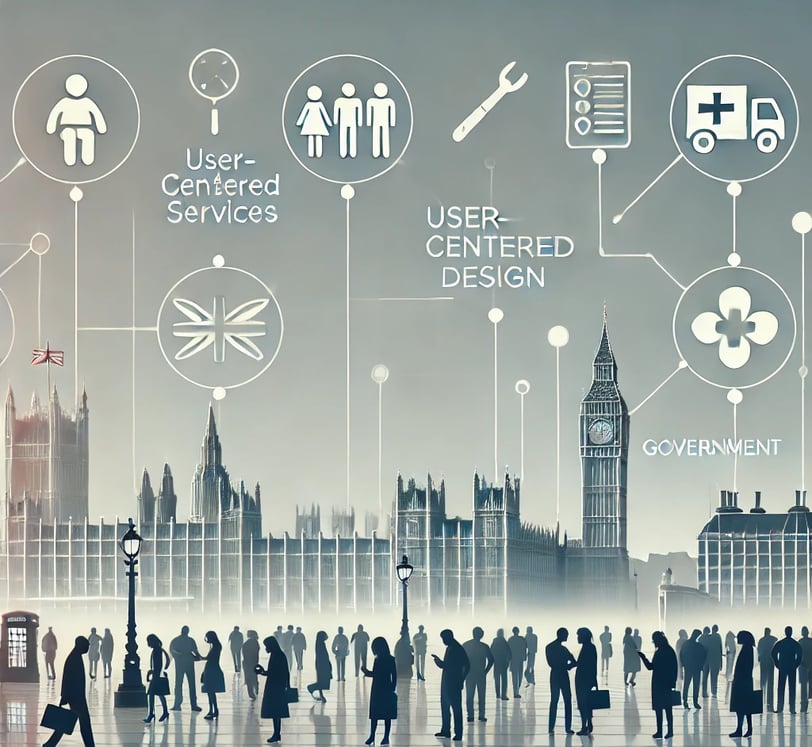Navigating the AI frontier: user-centered design for UK public services
Explore how user-centered design principles can enhance AI implementation in UK public services, addressing adoption challenges and ensuring citizen-centric technological advancements.
PUBLIC SECTOR, UCD AND AI
James Nicholls and Claude
9/10/20242 min read


As the UK government embraces artificial intelligence (AI) to transform public services, the role of user-centered design (UCD) becomes increasingly crucial. A recent report by the National Audit Office (NAO) sheds light on the current state of AI adoption in UK government, revealing both opportunities and challenges that demand our attention.
The current landscape of AI in UK public services
The NAO report highlights that AI adoption in the public sector is still in its early stages. Only 37% of surveyed government bodies have deployed AI, typically with just one or two use cases. However, there’s a growing appetite for AI, with 70% of respondents actively piloting or planning AI initiatives.
Key findings from the report include:
Limited widespread adoption: Despite the potential for transformation, AI is not yet widely used across government.
Focus on internal processes: Most deployed AI use cases aim to improve internal processes or support operational decision-making, rather than directly engaging with the public.
Skills shortage: 70% of respondents identified difficulties in recruiting or retaining staff with AI skills as a significant barrier to adoption.
The critical role of user-centered design
As someone who has worked extensively in UK government digital services, I can’t stress enough the importance of applying UCD principles to AI implementation. Here’s why UCD is crucial:
1. Ensuring AI serves citizen needs
UCD methodologies can help identify where AI can genuinely improve efficiency without compromising user experience. By involving citizens in the design process, we can create AI-driven services that truly meet their needs and expectations.
2. Building trust and transparency
The NAO report highlights that 43% of surveyed bodies identified lack of public trust as a barrier to AI adoption. UCD approaches can address this by:
Developing clear, accessible interfaces that explain AI decision-making processes.
Creating mechanisms for users to provide feedback and challenge AI-driven decisions.
Involving citizens in co-creation sessions to build trust from the ground up.
3. Promoting inclusivity and accessibility
As we develop AI-driven public services, it’s crucial to consider the diverse needs of all citizens. UCD techniques such as comprehensive user research and testing with diverse user groups can help identify and address potential biases in AI systems.
Challenges and opportunities ahead
The NAO report identifies several challenges in AI adoption, including:
Legacy IT infrastructure.
Data quality and access issues.
Lack of clear guidance and standards.
These challenges present opportunities for UCD practitioners to contribute their expertise. By collaborating with technical teams, we can ensure that AI solutions are built on a solid foundation of user needs and are designed for long-term sustainability.
Questions for reflection
How can we better integrate UCD principles into the development of AI governance frameworks for the public sector?
What role should citizens play in the design and deployment of AI-driven public services?
How can we balance the need for rapid AI adoption with the imperative of thorough user research and testing?
Call to action
As professionals working in the UK public sector, we have a responsibility to ensure that AI implementations serve the best interests of our citizens. I invite you to share your thoughts and experiences:
How have you seen UCD principles applied in AI projects within your organisation?
What challenges have you faced in balancing technological innovation with user needs?
What opportunities do you see for improving the integration of UCD in AI-driven public services?
Expertise
User-centered design for digital transformation projects.
Let's chat
Contact me
James@upkurve.com
+44(0)7599175359
© 2024. All rights reserved.
